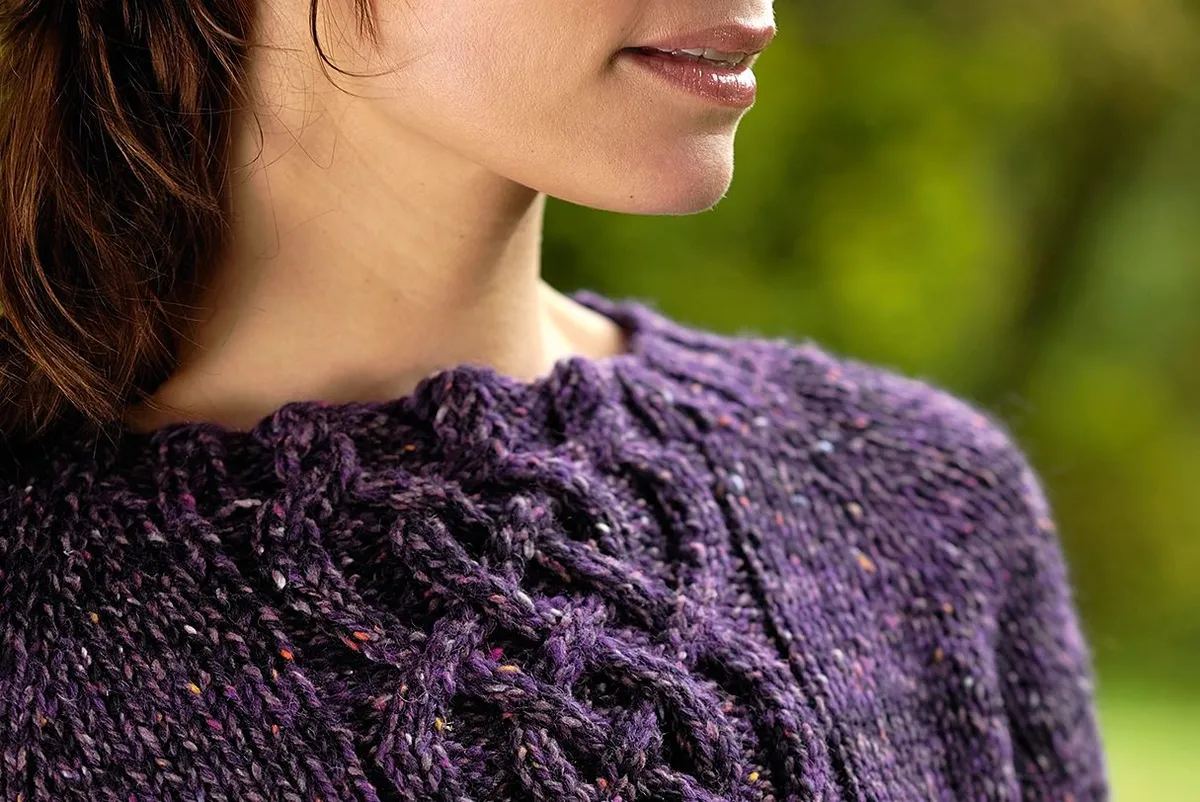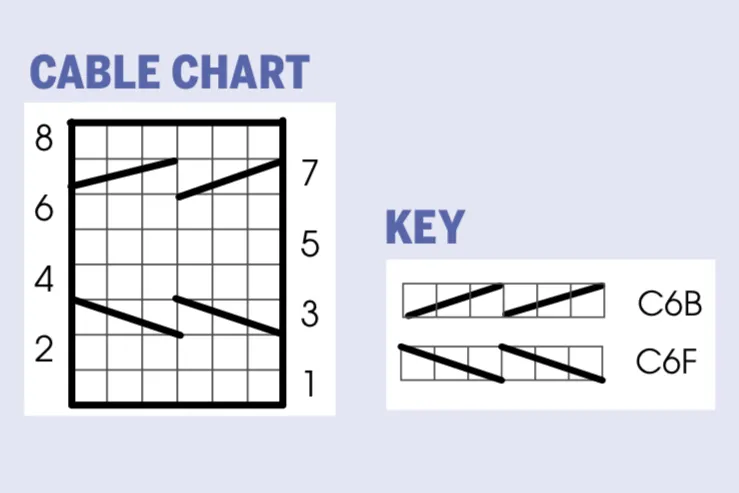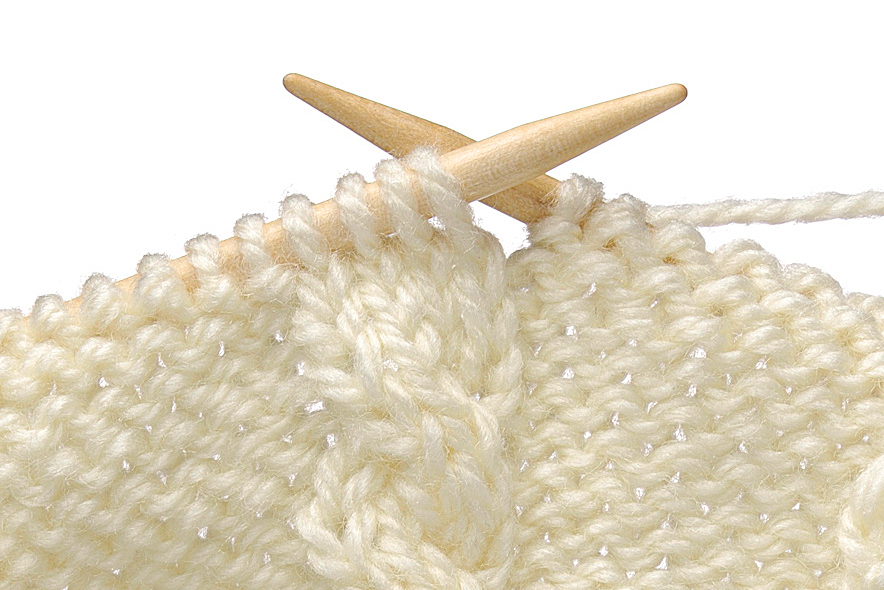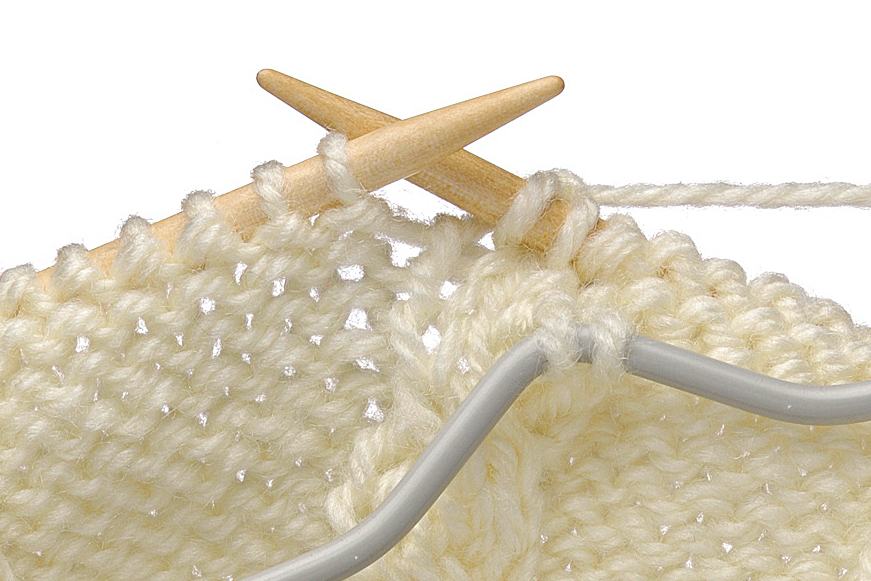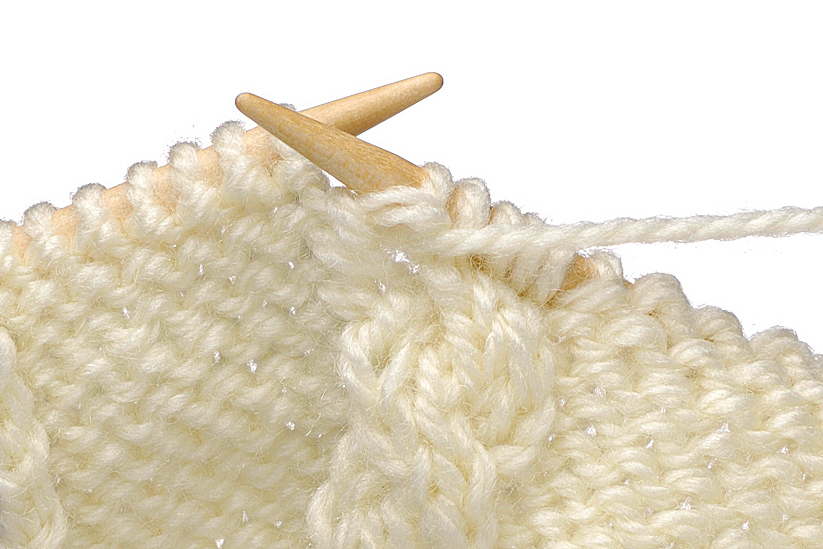C6B knitting stitch: how to Cable 6 Back
Twisting your cables in the other direction is just as simple. When you Cable 6 Back (C6B), you’ll create a twist that leans to the right. Working the cable over six stitches instead of four will also give your cable a chunkier look.
To practise this cable stitch, we recommend you use a smooth wool or acrylic-based DK yarn and a pair of 4mm needles. Cast on 22 stitches, and on the first row purl 8 stitches, knit 6 stitches, purl 8 stitches. This will be the right side of the fabric. Work the second row: K8, P6, K8. This will be the wrong side.
On the next row, you can start cabling. Work the row as follows: P8, C6B, P8. To help keep track of the central column of six stitches so you always knit the cable in the right place on the row, place stitch markers on both sides of it.
Work five rows ‘straight’ and then repeat the cabling row on every sixth row. Pull the yarn tightly either side of the panel.
Keep going until you feel confident with the technique. If it looks uneven, don’t worry – the more you practise the neater your cabling will get.
Step 1
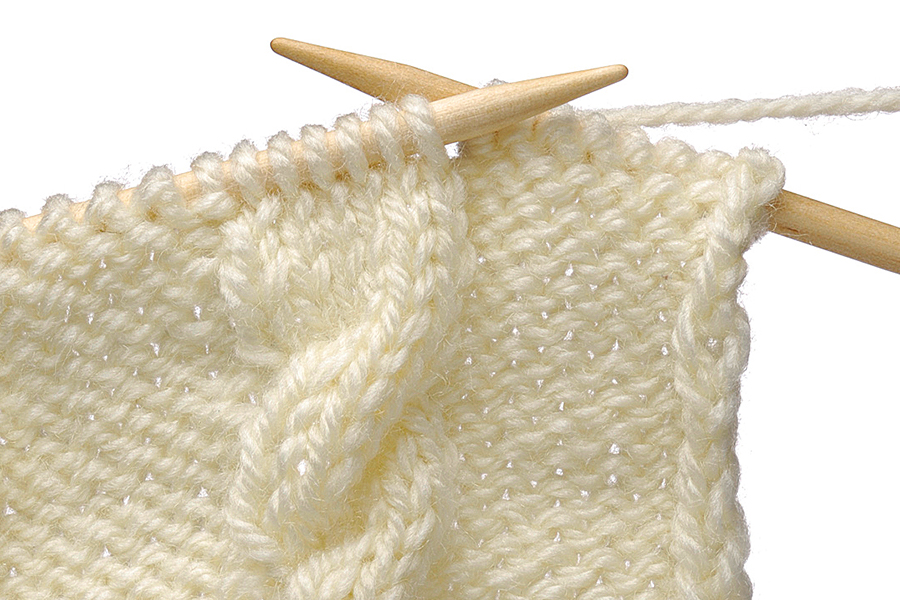
To work the C6B cabling technique, work the stitches of the background in reverse stocking stitch, up to where the cable pattern is going to begin. You could mark this with stitch markers.
Step 2
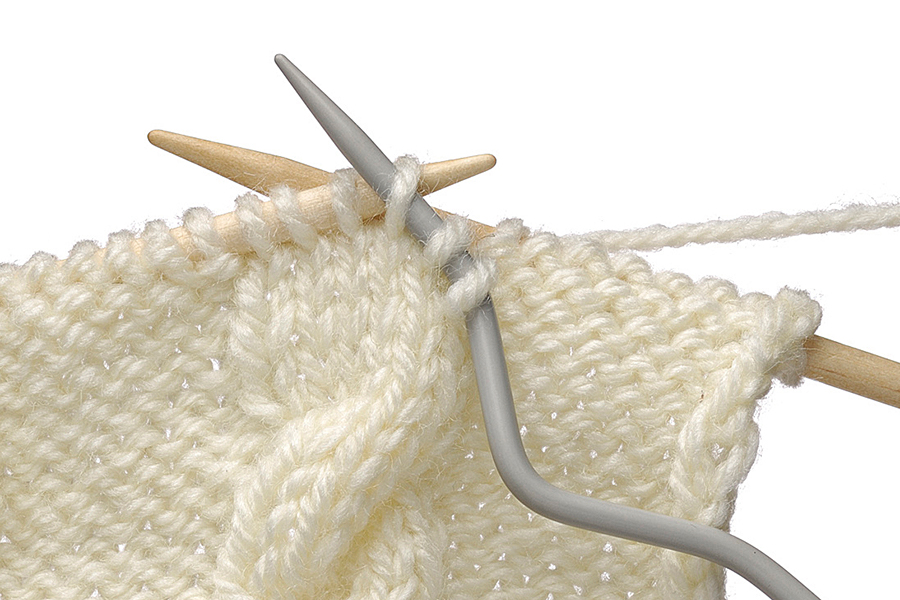
Next, work the cable pattern on the central column of six stitches. To do this, slip the next three stitches on to a cable needle. You could also use a spare double-pointed needle instead if you don’t have a cable needle.
Step 3

Take the cable needle with the three stitches to the back of the fabric (here, the cable needle is at the back of the knitting). Knit the next three stitches, pulling the first stitch tight to avoid ladders in the cable.
Step 4
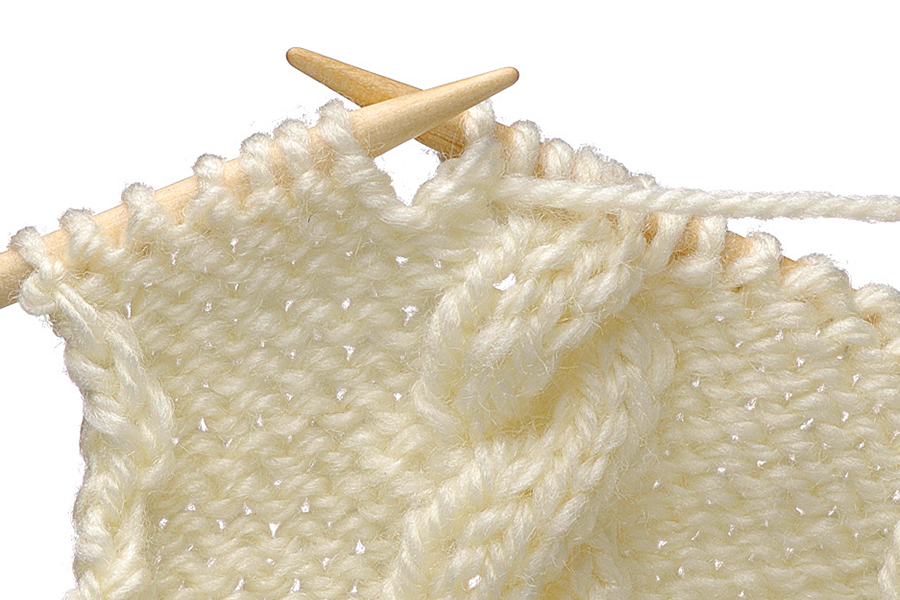
To complete the cable, bring the cable needle to the front of the fabric and knit the three stitches from the cable needle. Purl the next stitch and continue as instructed in your knitting pattern.
Cable needles: what to buy
The simplest cable needle is short and straight with points at both ends. Cable needles with a ‘V’ bend in the middle are more likely to stay put while you hold stitches on them. Some cable needles are ‘U’ shaped, so you can let go once the stitches are on. Slide the stitches onto the shorter end and knit off the longer end.
Cables are best worked in 4ply, DK, aran or chunky yarn. Cable needles usually come in pairs, one thin and one slightly thicker. Use the thin one for 4ply and DK yarns, and the thicker one for aran and chunky.
Crossing stitches over each other may cause them to stretch. You can avoid this by using a cable needle slightly smaller than your ‘main’ needles.
We recommend using a cable needle when you’re learning to cable knit. Once you’re more confident at cabling, it’s worth learning how to cable knit without a cable needle. It’s not as scary as it sounds, honest! Some knitters find they prefer cabling this way, while others stick to using a cable needle.
1. Straight cable needle
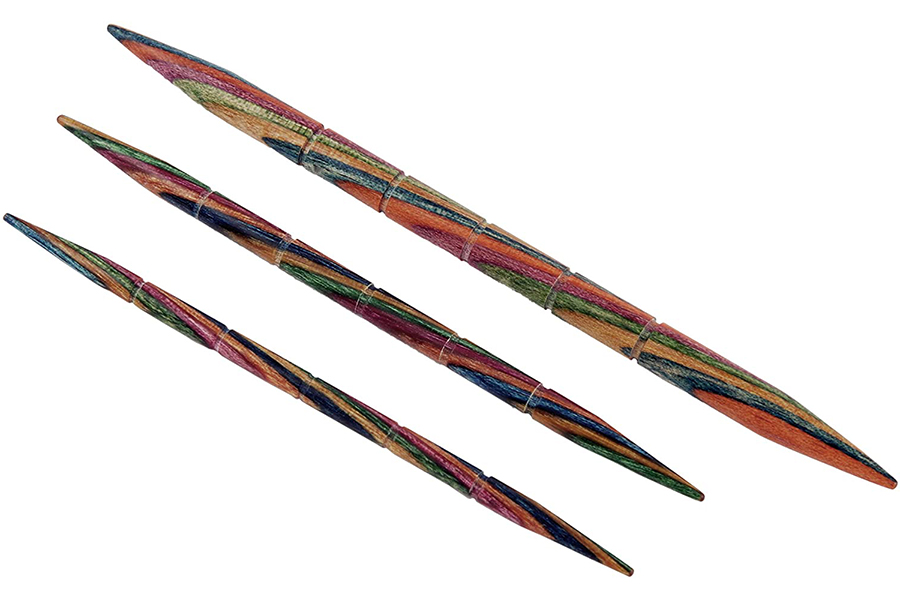
These classic straight cable needles from KnitPro are made in their gorgeous Symfonie wood. The tapered tips make it easy to pick stitches up, while grooves on the needles help to keep them in place. This three-pack includes sizes 3.25mm, 4mm and 5.5mm.
SQUIRREL_13078134
2. V-shaped cable needle
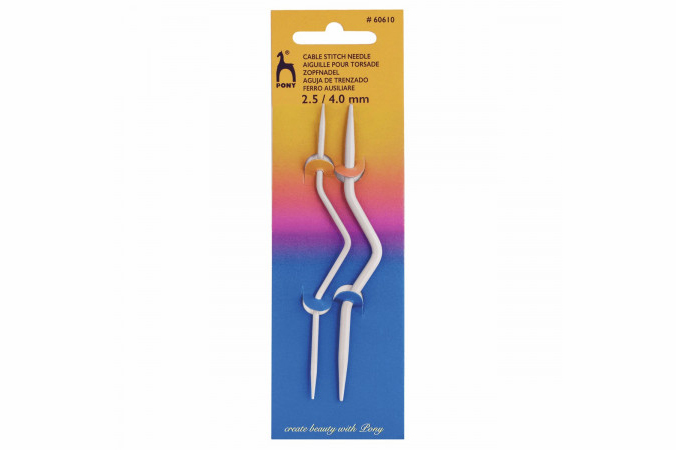
Pony’s popular cable needles have a curve to keep your held stitches where they’re meant to be, and are sleek and lightweight for easy knitting.
The pack includes two needles, one 2.5mm wide and one 4mm, great for lighter weight yarns.
SQUIRREL_13192529
3. U-shaped cable needle
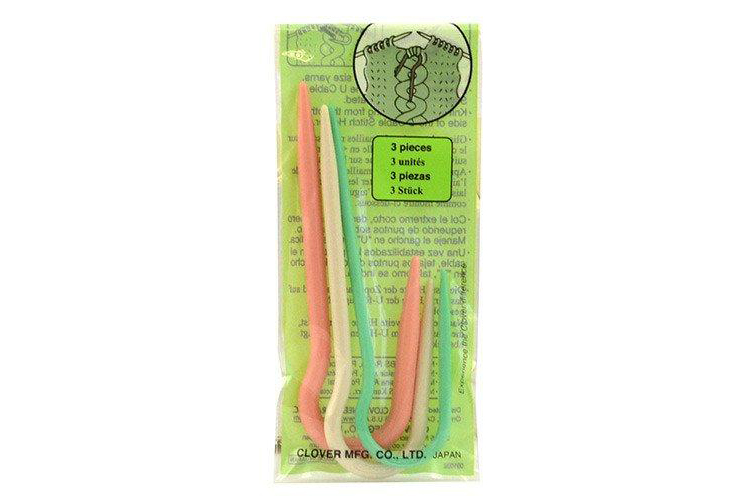
This U-shaped cable stitch holder from Clover is designed to help prevent dropped stitches, making it a great choice for beginners. It comes in a set of three, sized small, medium and large, to suit a range of different yarn weights.
SQUIRREL_13078133
4. Flexible cable needle
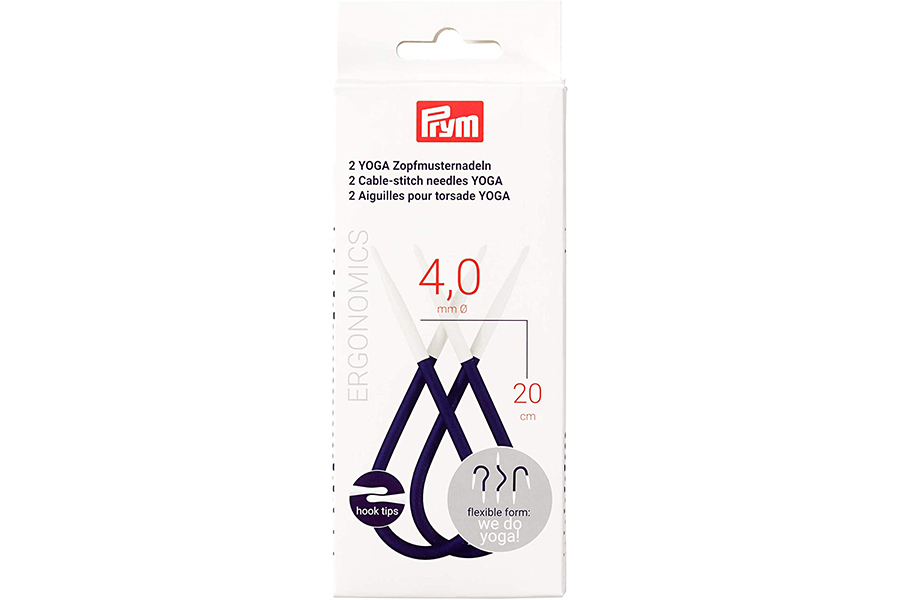
The Prym Yoga is a multi-functional cable needle, so as well as being great for cabling it also has a variety of other uses.
Its flexible shaft means that it’s handy for holding or marking stitches, or using as a spare knitting needle. 4mm wide, it comes in a pack of two.
SQUIRREL_13076669
Free cable knitting patterns: 3 to try
1. Knit a cable hat

Everyone needs a snuggly hat for winter, so make your first cable project this cosy head-warmer. Our unisex design is quick to knit, so grab a ball of your favourite DK yarn and cast on today!
Knit our free unisex cable hat pattern.
2. Knit a pair of fingerless gloves
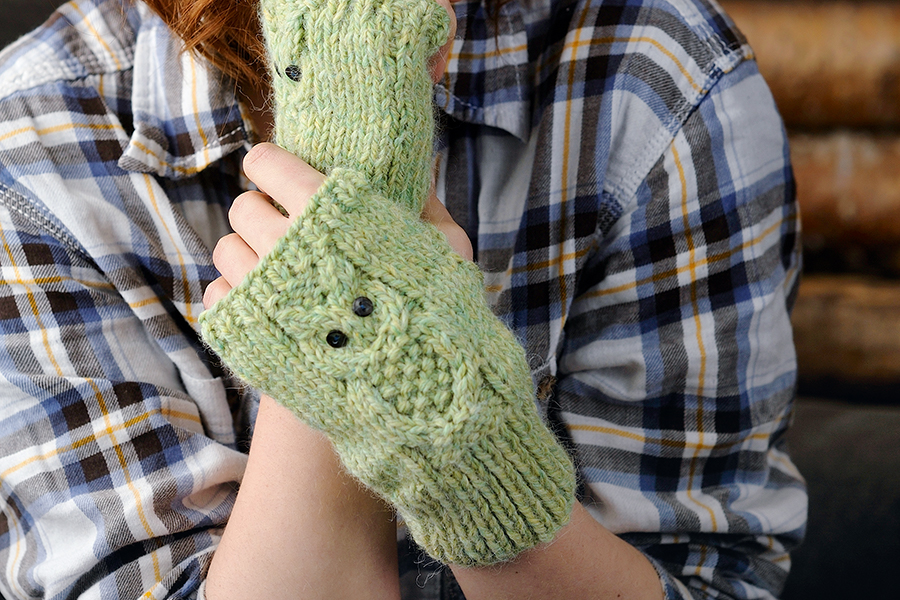
Cable knitting isn’t just about traditional gansey patterns (although we love those too!). Get creative with these playful owls, made from easy-to-knit cabled shapes and finished with button eyes.
Cast on the owl fingerless gloves knitting pattern.
3. Knit a bottle cosy
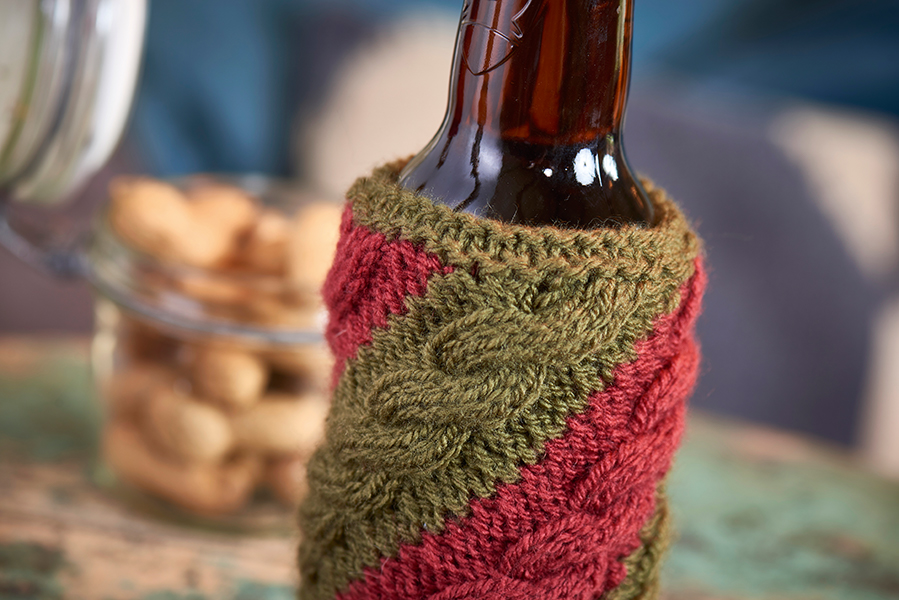
Keep your drink cool and your hands warm with our beer bottle cosy pattern. You can either knit it using a mixture of cables and intarsia colourwork, or make it in one shade for an easier knit.
Get the free beer cosy knitting pattern.
Cable stitch abbreviations
The world of cables can be confusing, especially if you see an abbreviation you’ve not done before. Sometimes cables can be called twists, so you might see T4F rather than C4F, but they often mean the same thing.
If you’re working from a pattern, it should give you an explanation of the abbreviation and how to work the stitch. In case you do see a term you don’t know, here’s a guide to explain some of the cabling and twisting techniques you might come across.
As you read through all these different cabling techniques, you’ll see that some twists work with odd numbers of stitches, while others create rib-effect cables by mixing up knit and purl stitches. There are near-endless possibilities for cabling and twisting stitches to create all sorts of effects!
C2B: Cable 2 Back
Slip next st to cable needle and hold at back of work, K1 from left needle, then K1 from cable needle.
C2F: Cable 2 Front
Slip next st to cable needle and hold at front of work, K1 from left needle, then K1 from cable needle.
C3B: Cable 3 Back
Slip next st to cable needle and hold at back of work, K2 from left needle, K1 from cable needle.
C3F: Cable 3 Front
Slip next st to cable needle and hold at front of work, K2 from left needle, K1 from cable needle.
Cr2b: Rib Cross 2 Back
Slip next st to cable needle and hold at back of work, K1 from left needle, then P1 from cable needle.
Cr2f: Rib Cross 2 Front
Slip next st to cable needle and hold at front of work, P1 from left needle, K1 from cable needle.
C4B: Cable 4 Back
Slip next 2 sts to cable needle and hold at back of work, K2 from left-hand needle, then K2 from cable needle.
C4F: Cable 4 Front
Slip next 2 sts to cable needle and hold at front of work, K2 from left needle, K2 from cable needle.
Cr4R: Odd Cross 4 Right
Slip next 3 sts onto cable needle and hold at back, K1 from left needle, K3 from cable needle.
Cr4L: Odd Cross 4 Left
Slip next st onto cable needle and hold at front, K3 from left needle, then K1 from cable needle.
C6B: Cable 6 Back
Slip next 3 sts to cable needle and hold at back of work, K3 from left needle, then K3 from cable needle.
C6F: Cable 6 Front
Slip next 3 sts to cable needle and hold at front of work, K3 from left needle, then K3 from cable needle.
C10B: Cable 10 Back
Slip 5 sts onto a cable needle, hold at back of work, K5 from left needle, then K5 from cable needle.
C10F: Cable 10 Front
Slip 5 sts onto a cable needle, hold at the front of work, K5 from left needle, then K5 from cable needle.
Tw3B: Purl Twist 3 Back
Slip next st onto cable needle and hold at back of work, K2 from left needle, then P1 from cable needle.
Tw3F: Purl Twist 3 Front
Slip next 2 sts onto cable needle, hold at front of work, P1 from left needle, K2 from cable needle.
T3B: Twist 3 Back
Slip next st onto cable needle, hold at back, K2 from left needle, then K1 from cable needle.
T3F: Twist 3 Front
Slip 2 sts onto cable needle, hold at front, K1 from left needle, then K2 from cable needle.
Tw4B: Purl Twist 4 Back
Slip 2 sts onto cable needle, hold at back, K2 from left needle, then P2 from cable needle.
Tw4F: Purl Twist 4 Front
Slip 2 sts onto cable needle, hold at front, P2 from left needle, then K2 from cable needle.
T8B rib: Twist 8 Back Rib
Slip next 4 sts onto cable needle and hold at back of work, K1, P2, K1 from left needle, then K1, P2, K1 from cable needle.
T8F rib: Twist 8 Front Rib
Slip next 4 sts onto cable needle and hold at front of work, K1, P2, K1 from left needle, then K1, P2, K1 from cable needle.
Cable knitting patterns: stitch library
Get creative with cables using our collection of cable stitch patterns. Our library features everything from simple plaits to basketweave cables and honeycomb eyelets.
Whether you’re looking for a simple twist to add to a hat or want to design your very own gansey, these patterns are sure to provide inspiration.
Why not practise your cable knitting by making a sampler blanket out of your test swatches? It’s a great way to learn how to cable knit!
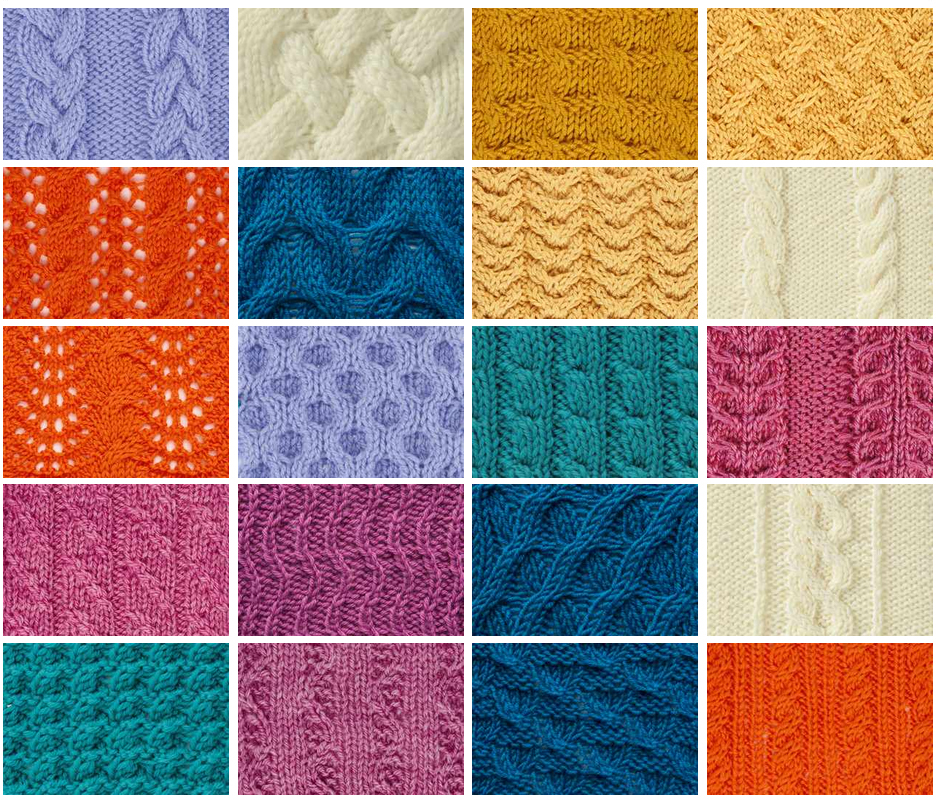
All of the patterns below use our standard knitting abbreviations. Here’s what you’ll find in our cable stitch library:

Cable knitting patterns: 9 stitch plait
Cast on 33 stitches.
Row 1 P5, K9, P5, K9, P5.
Row 2 K5, P9, K5, P9, K5
Row 3 P5, C6F, K3, P5, K3, C6B, P5.
Row 4 K5, P9, K5, P9, K5.
Row 5 P5, K9, P5, K9, P5.
Row 6 K5, P9, K5, P9, K5.
Row 7 P5, K3, C6B, P5, C6F, K3, P5.
Row 8 K5, P9, K5, P9, K5.
Repeat these 8 rows to desired length.

Cable knitting patterns: Basket cable 1
Add a traditional touch to your projects with this basketweave pattern.
Cast on a multiple of 8 sts plus 12 sts. (Try 44 sts.)
Row 1 (WS) K2, P to the last 2 sts, K2.
Row 2 Knit.
Rows 3 & 4 As rows 1 & 2.
Row 5 K2, P to the last 2 sts, K2.
Row 6 K2, (C8B) to last 2 sts, K2.
Rows 7-11 As rows 1-5.
Row 12 K6, (C8F) to last 6 sts, K6.
Repeat rows 1-12 to form pattern.
Abbreviations
C8B Slip 4 sts to a cable needle and hold at the back. K4, then K4 sts from the cable needle
C8F Slip 4 sts to a cable needle and hold in front. K4, then K4 sts from the cable needle
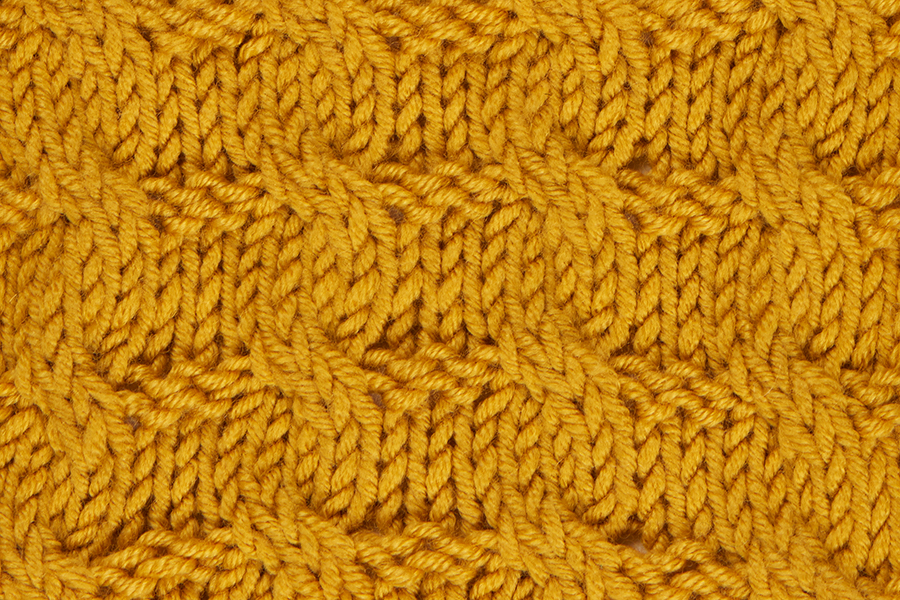
Cable knitting patterns: Basket cable 2
Cast on a multiple of 6 sts plus 2.
Row 1 WS Purl.
Row 2 Knit.
Row 3 Purl.
Row 4 Knit.
Row 5 K2, *P4, K2; rep from * to end.
Row 6 P2, *C4F, P2; rep from * to end.
Rows 1-6 form pattern.
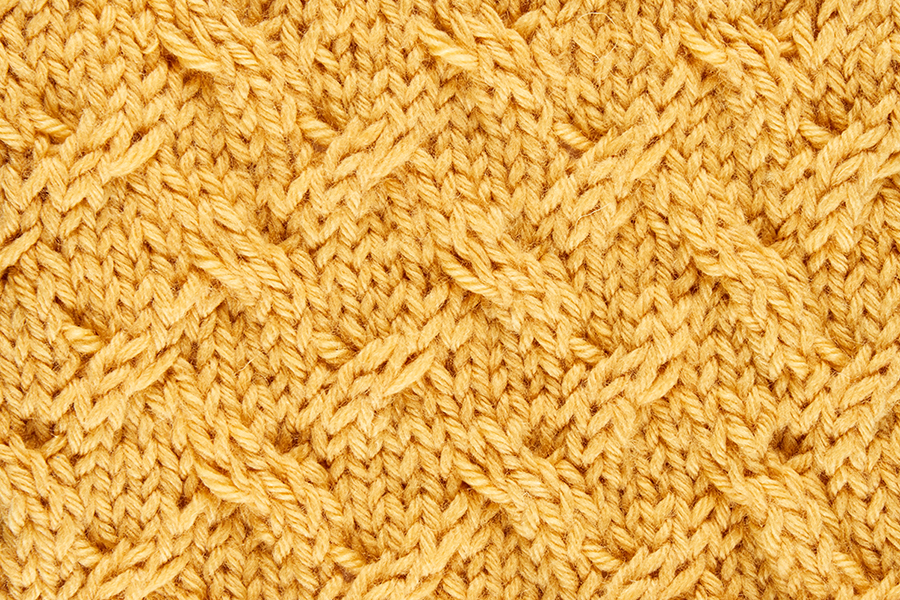
Cable knitting patterns: Basket cable 3
Cast on a multiple of 8 sts plus 2.
Row 1 (WS) Purl.
Row 2 Knit.
Row 3 Purl.
Row 4 K1, *sl next 2 sts to cn and hold in back, K2, then K2 from cn, K4.
Row 5 Purl.
Row 6 Knit.
Row 7 Purl.
Row 8 K1, *K4, sl next 2 sts to cn and hold in front, K2, then K2 from cn.
Rep rows 1–8 to form pattern.
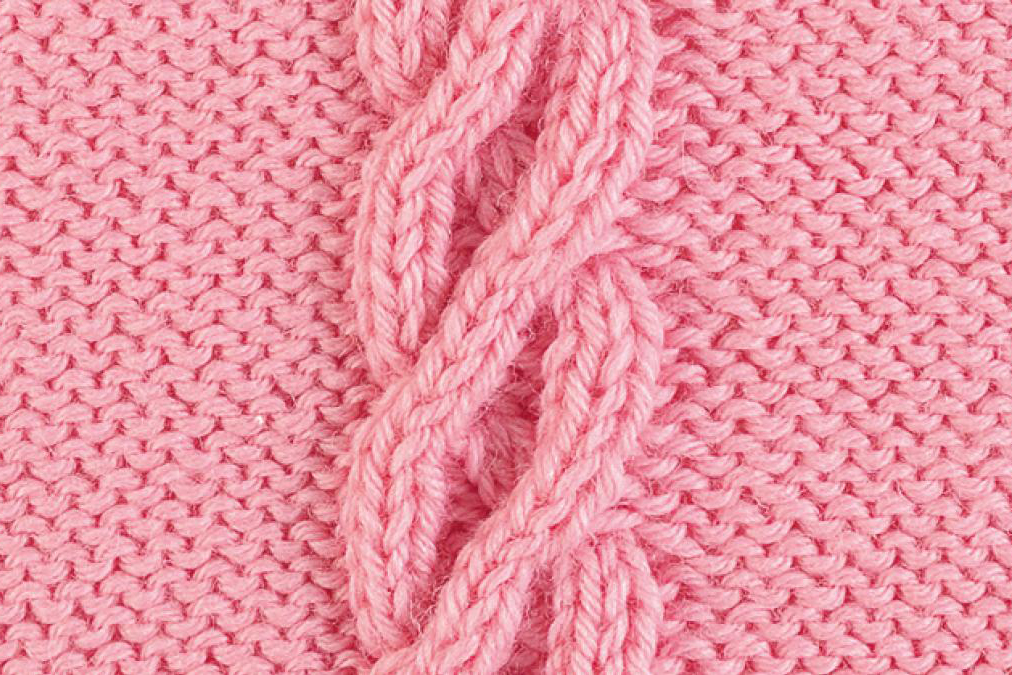
Cable knitting patterns: Cable rib
Cable worked over 10 stitches, with reverse stocking stitch. (Try 30 sts.)
Row 1 (RS) P10, K2, (P2, K2) twice, P10.
Row 2 K10, P2, (K2, P2) twice, K10.
Row 3 P10, T6L, P2, K2, P10.
Row 4 K10, P2, (K2, P2) twice, K10.
Rows 5-8 Rep rows 1 & 2 twice.
Row 9 P10, K2, P2, T6L, P10.
Row 10 K10, P2, (K2, P2) twice, K10.
Rows 11 & 12 Rep rows 1 & 2.
These 12 rows form the pattern.
Abbreviations
T6L (twist 6 left) Slip next 4 sts onto a cn and hold at front of work, K next 2 sts, then slip 2 purl sts from the cn on to the left-hand needle and purl them, then K2 sts from the cn.
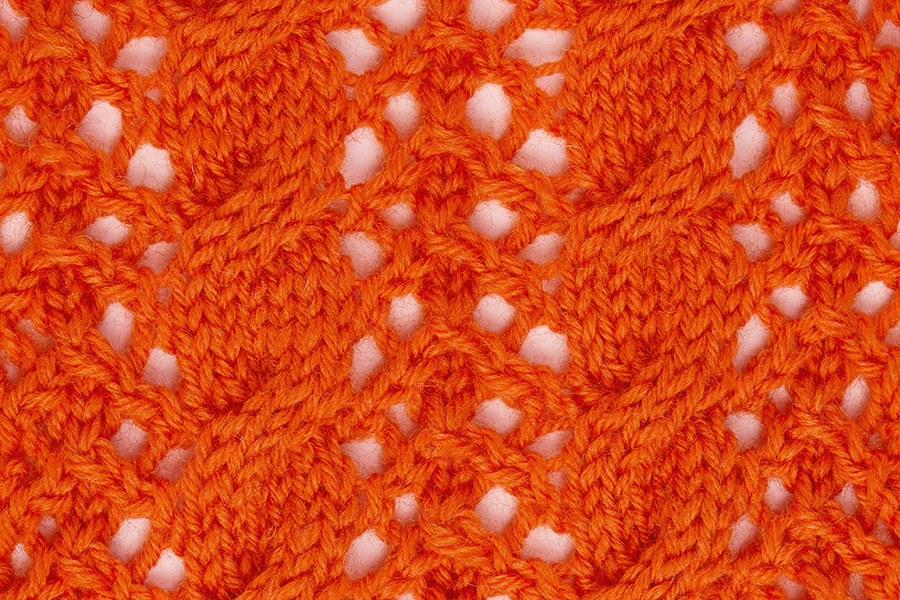
Cable knitting patterns: Cables & eyelets
Cast on a multiple of 11 sts plus 7.
Row 1 (WS) Purl.
Row 2 K1, *yo, ssk, K1, k2tog, yo, K6; rep from * to last 6 sts, yo, ssk, K1, k2tog, yo, K1.
Row 3 Purl.
Row 4 K2, *yo, sk2po, yo, K1, C6B, K1; rep from * to last 5 sts, yo, sk2po, yo, K2.
Row 5 Purl.
Row 6 K1, *yo, ssk, K1, k2tog, yo, K6; rep from * to last 6 sts, yo, ssk, K1, k2tog, yo, K1.
Row 7 Purl.
Row 8 K2, *yo, sk2po, yo, K8; rep from * to last 5 sts, yo, sk2po, yo, K2.
Rows 1–8 form pattern.
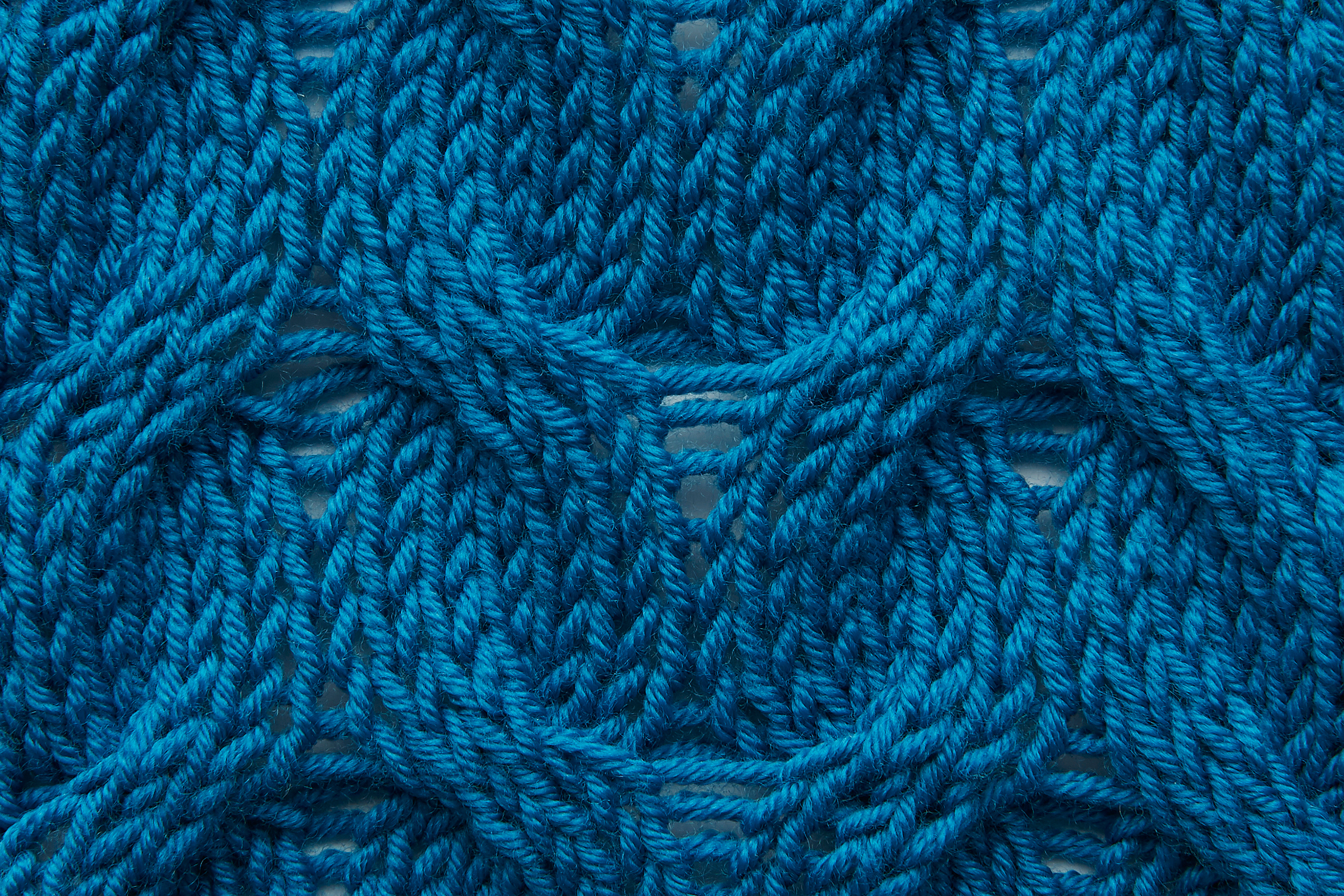
Cable knitting patterns: Chains & links
Cast on a multiple of 12 sts plus 2.
Row 1 (WS) Purl.
Row 2 K1, *C6B, C6F; rep from * to last st, K1.
Row 3 Purl.
Row 4 Knit.
Row 5 Purl.
Row 6 Knit.
Row 7 Purl.
Row 8 Knit.
Rows 1–8 form pattern.
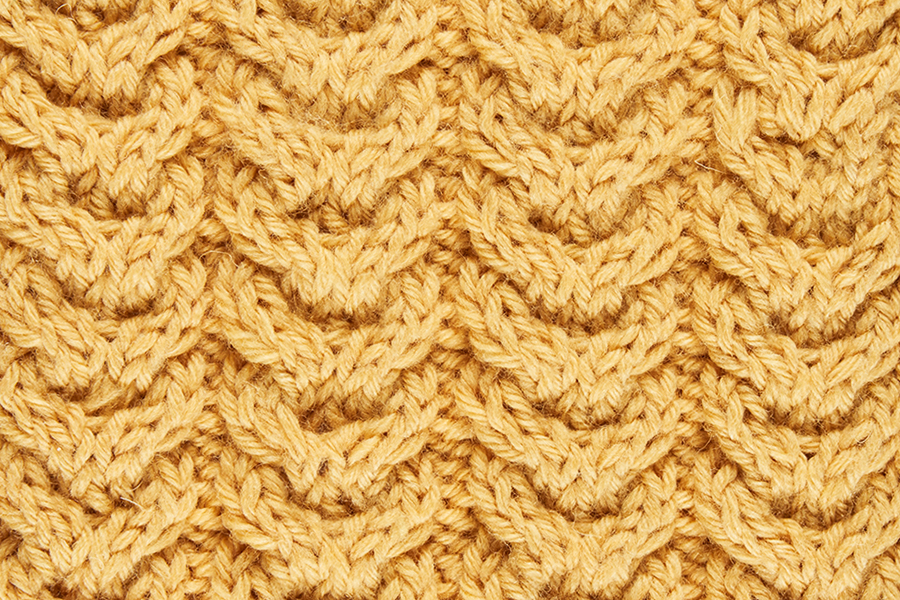
Cable knitting patterns: Chevron tracks
Cast on a multiple of 10 sts plus 2.
Row 1 (RS) P2, *K8, P2; rep from * to end.
Row 2 (WS) K2, *P8, K2; rep from * to end.
Row 3 P2, *sl2 sts to cn and hold in back, K2, K2 from cn, sl2 to cn and hold in front, K2, K2 from cn, P2; rep from * to end.
Row 4 K2, *P8, K2; rep from * to end.
Rep rows 1–4 to form pattern.

Cable knitting patterns: Corded cable rib
Cast on 32 sts.
Row 1 (RS) P6, K6, P8, K6, P6.
Row 2 K6, P6, K8, P6, K6.
Row 3 P6, K6, P8, K6, P6.
Row 4 K6, P6, K8, P6, K6.
Row 5 P6, C6B, P8, C6F, P6.
Row 6 K6, P6, K8, P6, K6.
Repeat rows 1–6 to form the pattern.
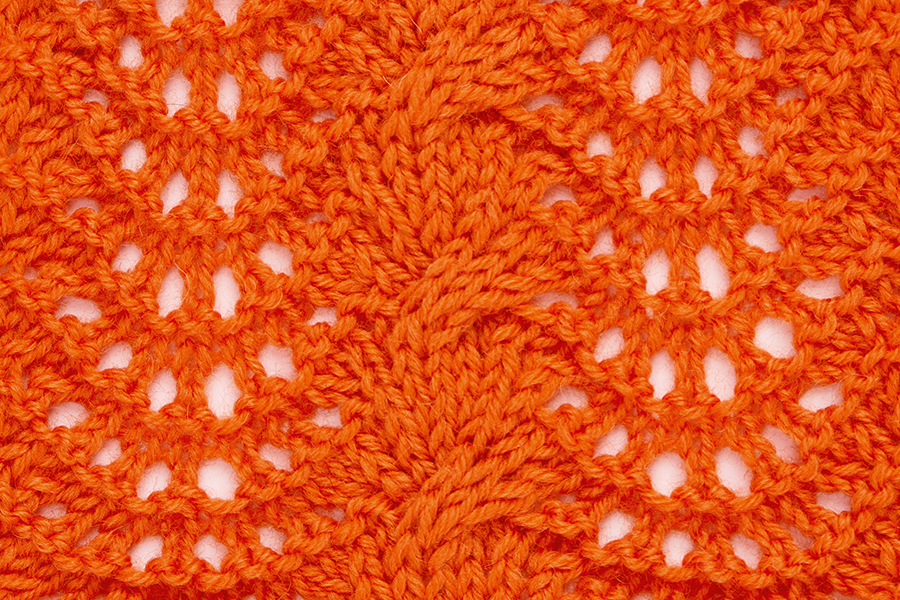
Cable knitting patterns: Fans & feathers
Cast on a multiple of 18 sts.
Row 1 (WS) Purl.
Row 2 *(K2tog) 3 times, (yo, K1) 6 times, (k2tog) 3 times; rep from * to end.
Row 3 K15, *P6, K12; rep from * to last 3 sts, K3.
Row 4 K15, *C6B, K12; rep from * to last 3 sts, K3.
Row 5 Purl.
Row 6 *(K2tog) 3 times, (yo, K1) 6 times, (k2tog) 3 times; rep from * to end.
Row 7 K15, *P6, K12; rep from * to last 3 sts, K3.
Row 8 Knit.
Rows 1–8 form pattern.

Cable knitting patterns: Honeycomb
Cast on 32 stitches.
Row 1 *C4B, C4F, repeat from * to end of row.
Row 2 P.
Row 3 K.
Row 4 P.
Row 5 *C4F, C4B, repeat from * to end of row.
Row 6 P.
Row 7 K.
Row 8 P.
Repeat these 8 rows to desired length.

Cable knitting patterns: Little cable rib
Cast on a multiple of 6 sts. (Try 42 sts.)
Row 1 (RS) *K3, P3; rep from * to end.
Row 2 *Knit the knit sts and purl the purl sts; rep from * to end.
Row 3 *K3, P3; rep from * to end.
Row 4 *Knit the knit sts and purl the purl sts; rep from * to end.
Row 5 *K1, LC, P1; rep from * to end.
Row 6 *Knit the knit sts and purl the purl sts; rep from * to end.
Rep rows 1-6 to form pattern.
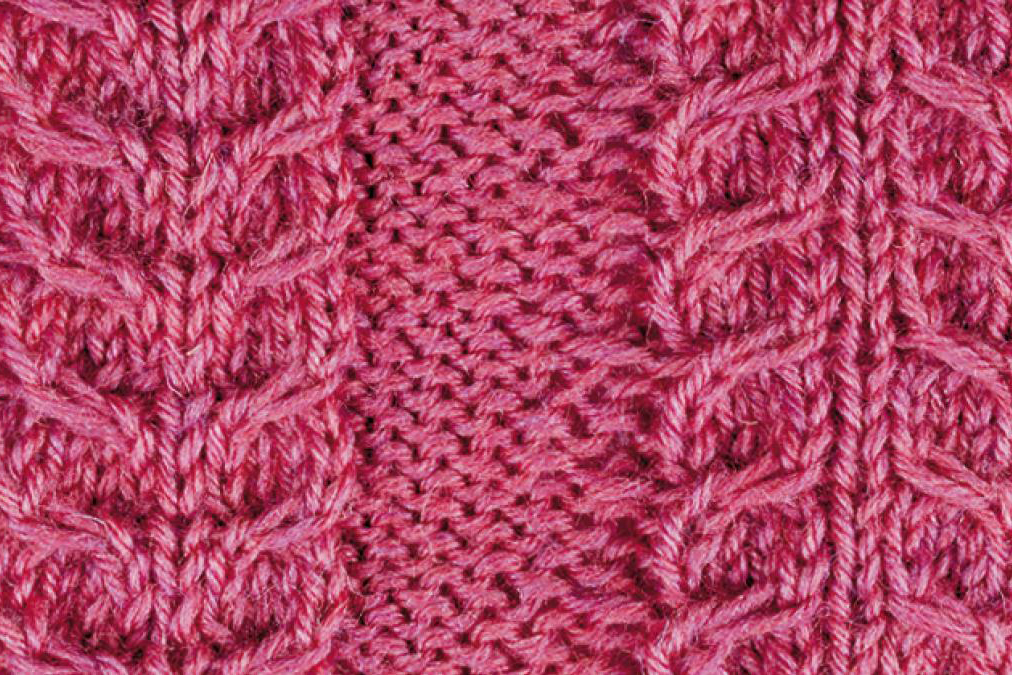
Cable knitting patterns: Mini cables
These Mini Cables are worked using an uneven cabling method.
Usually, cables are worked by slipping two or so stitches onto a cable needle and then working the next two stitches from the left-hand needle, before working those two stitches from the cable needle.
In this case, instead of splitting the stitches evenly into two and two, it’s three and one.
Cast on 9 sts per cable on a background of rev st st. (Try 43 sts.)
Row 1 (RS) P8, K9, P9, K9, P8.
Row 2 K8, P9, K9, P9, K8.
Row 3 P8, Cr4L, K1, Cr4R (left pattern), P9, Cr4R, K2, Cr4L (right pattern), P8.
Row 4 As Row 2.
Repeat these 4 rows to form the pattern.
Abbreviations
Cr4L Slip next st onto cn and hold at front. K3 from LH needle, then K1 from cn.
Cr4R Slip next 3 sts onto cn and hold at back. K1 from LH needle, K3 from cn.

Cable knitting patterns: Mock cables
Cast on a multiple of 7 sts plus 2.
Row 1 (WS) K2, *P5, K2; rep from * to end.
Row 2 P2, *LT, K3, P2; rep from * to end.
Row 3 K2, *P5, K2; rep from * to end.
Row 4 P2, *K1, LT, K2, P2; rep from * to end.
Row 5 K2, *P5, K2; rep from * to end.
Row 6 P2, *K2, LT, K1, P2; rep from * to end.
Row 7 K2, *P5, K2; rep from * to end.
Row 8 P2, *K3, LT, P2; rep from * to end.
Rows 1–8 form pattern.
Abbreviations
LT (Left twist) Skip 1st st, K into back of 2nd st, K the skipped st, then slip both sts from needle tog
RT (Right twist) Skip 1st st, K into front of 2nd st, K the skipped st, then slip both sts from needle tog
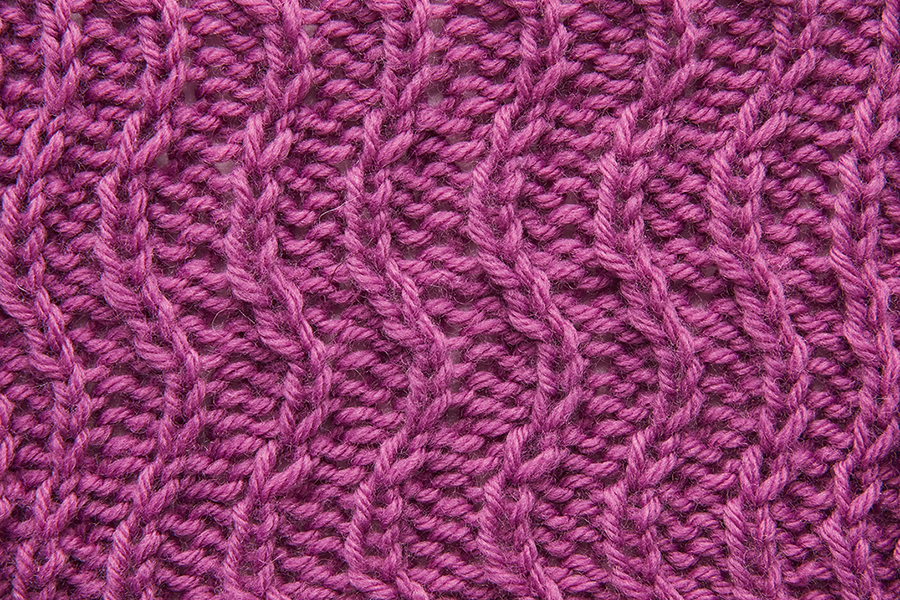
Cable knitting patterns: Ripple effect
Cast on a multiple of 3 sts plus 1.
Row 1 *P1, T2B; rep from * to last st, P1.
Row 2 and all even rows Knit the knit sts and purl the purl sts.
Row 3 K1, P1, *T2B, P1; rep from * to last 2 sts, T2B.
Row 5 *K1, P2; rep from * to last st, K1. Row 7 P2, *T2F, P1; rep from * to last 2 sts, T2F.
Row 9 *P2, K1; rep from * to last st, P2. Row 11 *P1, T2F; rep from * to last st, P1.
Row 12 Knit the knit sts and purl the purl sts.
Rows 1–12 form pattern.
Abbreviations
T2F Slip next st to cable needle and hold at front, P1; K1 from cable needle
T2B Slip next st to cable needle and hold at back, K1; P1 from cable needle
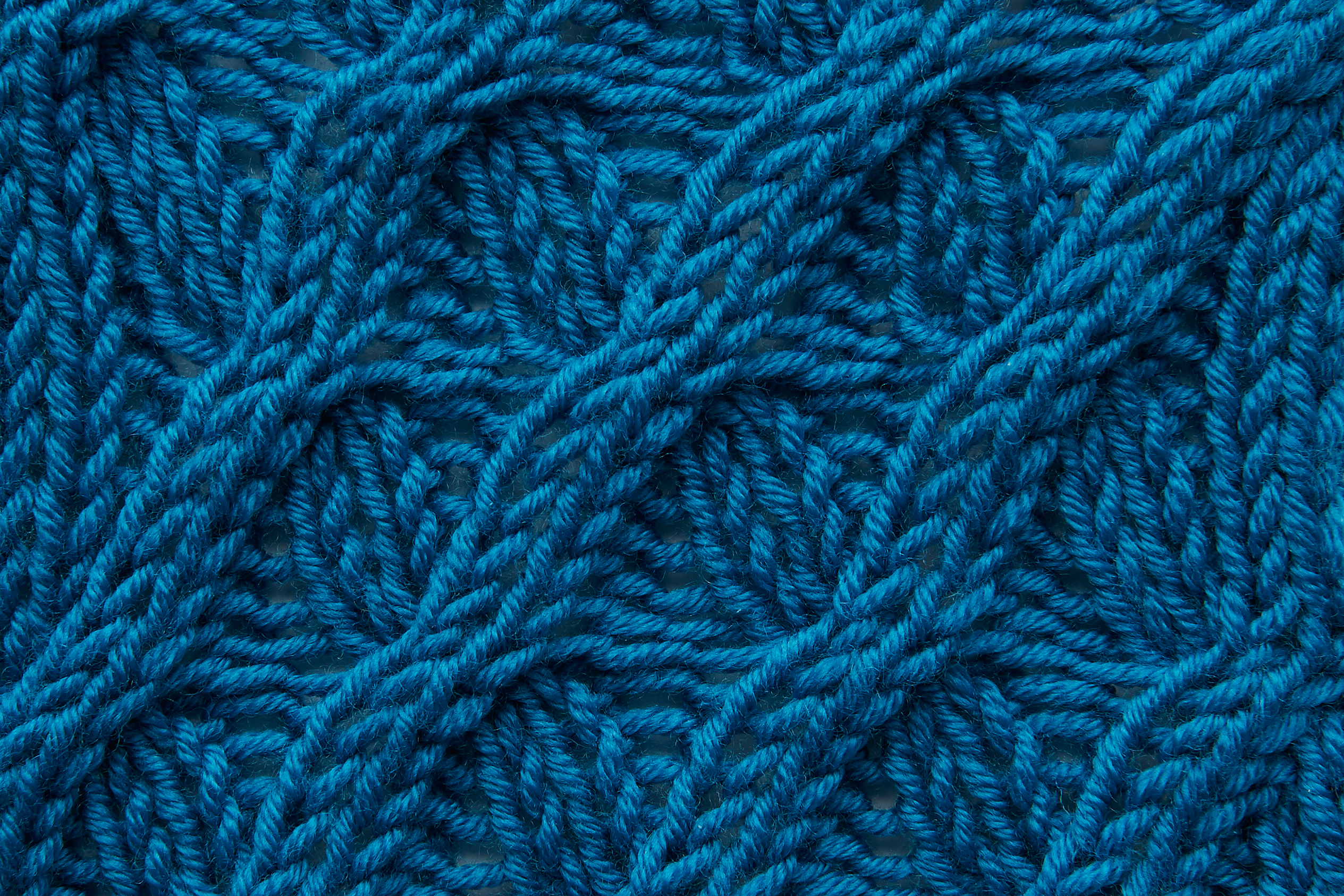
Cable knitting patterns: Rolling waves
Cast on a multiple of 6 sts plus 1.
Row 1 (RS) P1, *K2, P1; rep from * to end.
Row 2 and all even rows Knit the knit sts and purl the purl sts.
Row 3 P1, *K2, P1; rep from * to end.
Row 5 P1, K2, P1, *CO, P1; rep from * to last 3 sts, K2, P1.
Row 7 P1, *K2, P1; rep from * to end.
Row 9 P1, *K2, P1; rep from * to end.
Row 11 P1, *CO, P1; rep from * to end.
Row 12 Knit the knit sts and purl the purl sts.
Rows 1-12 form pattern.
Abbreviations
CO Crossover: slip 3 sts to cn and hold to back, K2, return P st from cn to left needle and P1, then K2 from cn

Cable knitting patterns: Slanted double cable
Cast on 18 sts, plus some sts for the background of reverse st st. (Try 40 sts. This will give you 10 sts either side of the 20 for the cable.)
Row 1 (RS) P10 (or half of the extra sts cast on), pm, K1 tbl, P2, K2, P4, K4, P2, K1 tbl, pm, P to end.
Row 2 and every alt row Knit the knit stitches and purl the purl stitches.
Row 3 P to marker, slm, K1 tbl, P2, LC, P2, K4, P2, K1 tbl, slm, P to end.
Row 5 P to marker, slm, K1 tbl, P4, C4F, LC, P2, K1 tbl, slm, P to end.
Row 7 P to marker, slm, K1 tbl, P2, RC, LC, K2, P2, K1 tbl, slm, P to end.
Row 9 P to marker, slm, K1 tbl, P2, K2, P4, C4F, P2, K1 tbl, slm, P to end.
Row 10 As row 2.
Repeat rows 3–10 to form pattern.
Abbreviations
LC (left cross) Slip 2 sts to cable needle and hold in front, P2, K2 from cable needle
RC (right cross) Slip 2 sts to cable needle and hold at back, K2, then P2 from cable needle

Cable knitting patterns: Soft cables
Add all-over texture to your knits with this simple cable pattern.
Cast on a multiple of 4 sts plus 2 sts. (Try 42 sts.)
Row 1 (RS) K1, *P2, K2; rep from * ending K3.
Row 2 P3, *K2, P2; rep from * ending P1.
Row 3 K1, *C4B; rep from * ending K1.
Row 4 *Knit; rep from * to end.
Rep Rows 1-4 to form pattern.
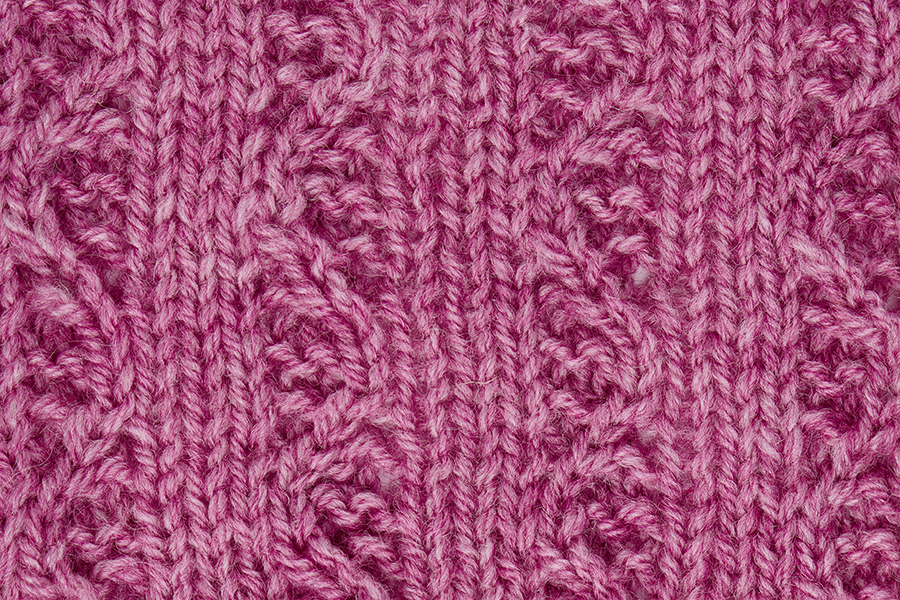
Cable knitting patterns: Subtle curves
Cast on a multiple of 6 sts plus 1.
Row 1 (RS) Knit.
Row 2 P2, *K2, P4; rep from * to last 5 sts, K2, P3.
Row 3 K2, *LT, K4; rep from * to last 5 sts, LT, K3.
Row 4 P2, *K1, P1, K1, P3; rep from * to last 5 sts, K1, P1, K1, P2.
Row 5 K3, *LT, K4; rep from * to last 4 sts, LT, K2.
Row 6 P3, *K2, P4; rep from * to last 4 sts, K2, P2.
Row 7 Knit.
Row 8 P3, *K2, P4; rep from * to last 4 sts, K2, P2.
Row 9 K3, *RT, K4; rep from * to last 4 sts, RT, K2.
Row 10 P2, *K1, P1, K1, P3; rep from * to last 5 sts, K1, P1, K1, P2.
Row 11 K2, *RT, K4; rep from * to last 5 sts, RT, K3.
Row 12 P2, *K2, P4; rep from * to last 5 sts, K2, P3.
Rows 1–12 form pattern.
Abbreviations
LT (Left twist) Skip 1st st, K into back of 2nd st, K the skipped st, then slip both sts from needle tog
RT (Right twist) Skip 1st st, K into front of 2nd st, K the skipped st, then slip both sts from needle tog
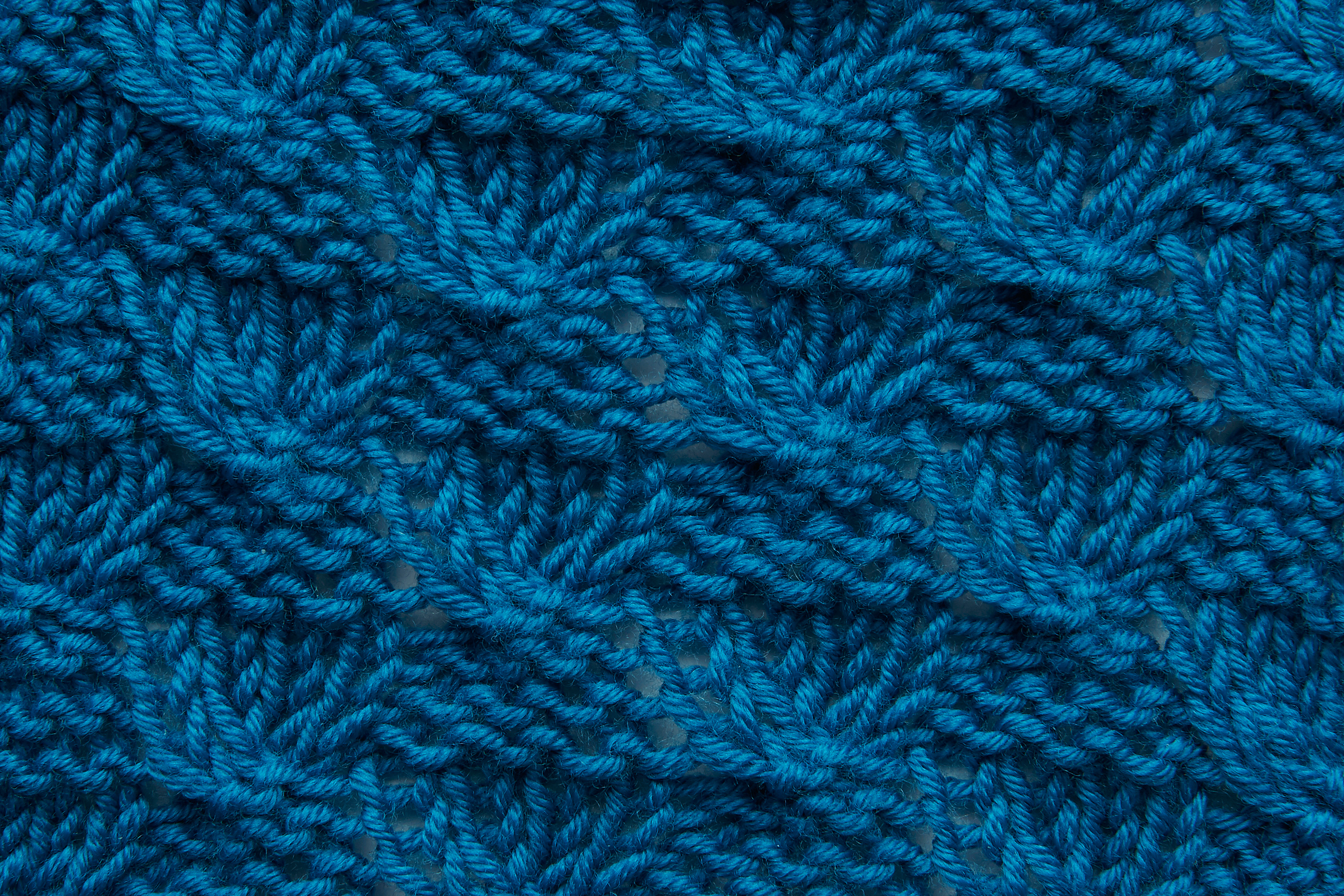
Cable knitting patterns: Trapeziums
Cast on a multiple of 8 sts.
Row 1 (WS) *K4, P4; rep from * to end.
Row 2 *K4, P4; rep from * to end.
Row 3 *K4, P4; rep from * to end.
Row 4 *K4, P4; rep from * to end.
Row 5 *P4, C4F; rep from * to end.
Row 6 *K4, P4; rep from * to end.
Row 7 *K4, P4; rep from * to end.
Row 8 *K4, P4; rep from * to end.
Row 9 *C4F, P4; rep from * to end.
Rows 2-9 form pattern.

Cable knitting patterns: Twists & turns
Cast on a multiple of 9 sts plus 6.
Row 1 (RS) *P1, K4, (P1, K1) twice; rep from * to last 6 sts, P1, K4, P1.
Row 2 *K1, P4, (K1, P1) twice; rep from * to last 6 sts, K1, P4, K1.
Row 3 *P1, C4B, (P1, K1) twice; rep from * to last 6 sts, P1, C4B, P1.
Row 4 *K1, P4, (K1, P1) twice; rep from * to last 6 sts, K1, P4, K1.
Rows 1–4 form pattern.

Cable knitting patterns: Wavy cables
Cast on a multiple of 8 sts. (Try 48 sts.)
Row 1 (RS) *K4, C4B; rep from * to end of row.
Row 2 Purl.
Row 3 *C4F, K4; rep from * to end of row.
Row 4 Purl.
Repeat these 4 rows to desired length.
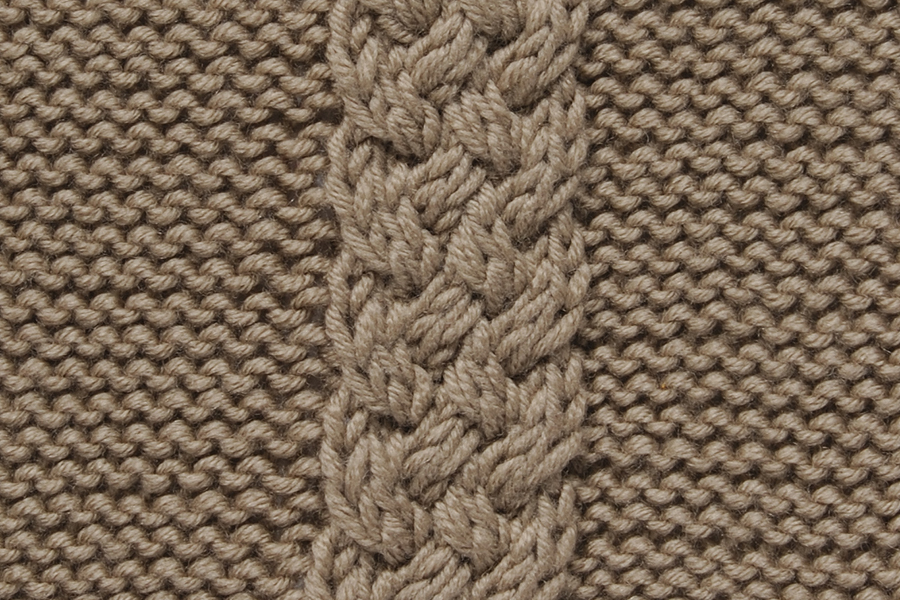
Cable knitting patterns: Woven cable
Cast on a multiple of 4 sts plus 6. (Example shown here is over 10 sts on a reverse st st background.)
Row 1 (RS) K2, *C4F, rep from * to end.
Row 2 Purl.
Row 3 *C4B, rep from * to last 2 sts, K2.
Row 4 Purl.
Repeat these 4 rows to desired length.
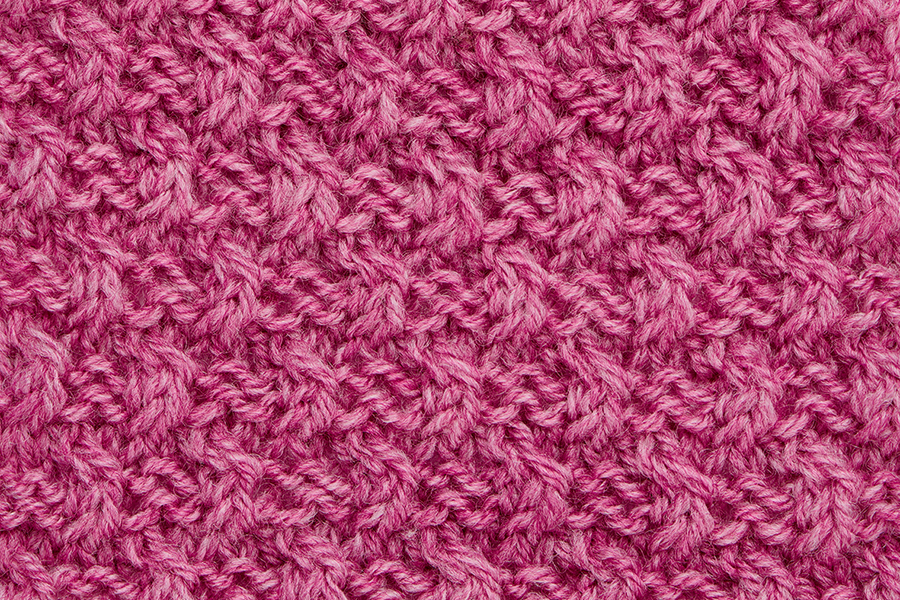
Cable knitting patterns: Woven twists
Cast on a multiple of 4 sts.
Row 1 (WS) Purl.
Row 2 K1, P2, *LT, P2; rep from * to last st, K1.
Row 3 K3, *P2, K2; rep from * to last st, K1.
Row 4 K3, *RT, K2; rep from * to last st, K1.
Row 5 Purl.
Row 6 K1, *LT, P2; rep from * to last 3 sts, LT, K1.
Row 7 K1, P2, *K2, P2; rep from * to last st, K1.
Row 8 K1, *RT, K2; rep from * to last 3 sts, RT, K1.
Rows 1–8 form pattern.
Abbreviations
LT (Left twist) Skip 1st st, K into back of 2nd st, K the skipped st, then slip both sts from needle tog
RT (Right twist) Skip 1st st, K into front of 2nd st, K the skipped st, then slip both sts from needle tog
Cable knitting: Easier than you think!
Learning how to cable knit is simpler than you think, as you can see from our guide, it’s easy to pick up a variety of cable knit styles once you know the technique!
Need a bit more guidance on your knitting journey?
We have a fabulous how-to knit guide, which is jam-packed with helpful tips and tricks (even seasoned stitchers will get a kick out of this)!
